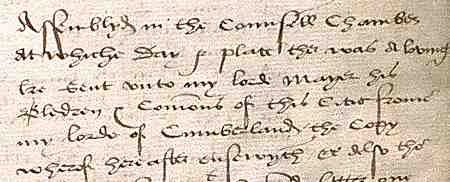Script Type : minuscule cursive
Date : mid 16th century
Location : England
Function : document hand or business and personal hand
























Distinctive letters: This example shows an ordinary cursive 16th century business hand written in English, formal enough for use for an official purpose, but nonetheless used in a document rapidly written which retains deletions and corrections. The hand is fully cursive and therefore able to be written at speed.
By this date, English cursive writing has lost some of the distinctive letter forms that are ascribed to the script called cursiva anglicana. The letter a is simple with only a single closed section, while g looks a bit like a y with a cross through it. The letter r is the simplified Gothic form, looking rather like a z.
Ascenders and descenders are generally loopy, and the hasty nature of the script means that b and d have a tendency to be open in the bottom loop.
The letter e is variable, sometimes having the form where it seems to have rolled over on its back. At other times it descends into an informal squiggle. The letter h has a loopy descender and appears to be falling off the line, as is common in cursive scripts of this date. Even the letter k has a curvy shape. The letter x is written as a curly closed loop made from a single penstroke. The letter w has evolved into a simplified curvy form, without the curly elaborations of earlier scripts. The letter y has a curly descender which, to our eyes, curls the wrong way.
The letter c retains a flat topped shape, while t is short, so these can sometimes be confused.
Both f and long s are especially long and curvy, while s when it appears at the end of a word has evolved from the short and curly form to a simplified upward curly flourish.
As with so many later cursive scripts, the letters made of minims can be difficult to resolve and n and u are virtually indistinguishable. See the word Counsell in the first line. When this is combined with the erratic spelling of the 16th century, it can sometimes be hard to decide which it is meant to be. The letter v is angular, with a flourish, at least where it appears at the beginning of a word.
The combination th has been written out in full in this instance, rather than using y.
There are no examples of j, q or z in this sample.
Pass the cursor slowly over the text segment for a transcript. Further details can be examined in the paleography exercise.
Paleography
exercises using Flash ![]()
Requires at least the Flash 5 plugin
If you are looking at this page without frames, there is more information about medieval writing to be found by going to the home page (framed) or the site map (no frames).